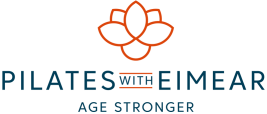Good alignment is important – your pilates class is a chance to retrain muscle habits. Quick posture checks before and during any movement can help you avoid injury and get maximum benefit from your class. Here is what you need to know:
- Stand up straight. When I ask you to stand up tall, that means keeping your:
- chin parallel to the floor
- shoulders even (roll them up, back, and down to help achieve this)
- arms at your sides, elbows relaxed and even
- abdominal muscles pulled in
- hips even and level
- neutral pelvis, natural curve of lumbar spine present, with ASIS* & pubic bone in same plane
- body weight evenly distributed on both feet.
*ASIS = anterior superior iliac crest (or front and top of your hips)
- Strive for neutral.
Neutral alignment means keeping your body in a straight line from head to toe except for the slight natural curves of the spine. Whether you’re standing or seated, that means your spine is not flexed (to flatten lumbar) or  arched (to overemphasise the curve of the lower back.)
arched (to overemphasise the curve of the lower back.)
One means of finding neutral is to tip your pelvis forward as far as is comfortable, then tip it backward as far as is comfortable. Neutral is roughly in the middle. If you’re not used to standing or sitting up straight, it may take a while for this to feel natural.
Note: if you have an exaggerated lumbar curve (anterior pelvic tilt or ‘lumbar lordosis’), you should strive to go beyond neutral and tilt towards a posterior pelvic tilt to stretch and decompress the lower back. Also, if weak the abdominals, it helps to tilt the pelvis to achieve stability when legs are raised from the lying-on-your-back postion.
- Focus on angles
Think back to set squares in school. Visualise a 90-degree angle as the letter ‘L’. I often refer to a 90-degee or 45-degree angle for where your legs may be in relation to your torso. Mentally slice the 90-degree angle in half for 45 degrees.
It all takes time and practice. Take a few moments each day to practice better posture – even weight on both feet; roll shoulders up, back and down; lift through crown of head; abs gently contracted, sensing your centre as you quieten yourself through your breath.

